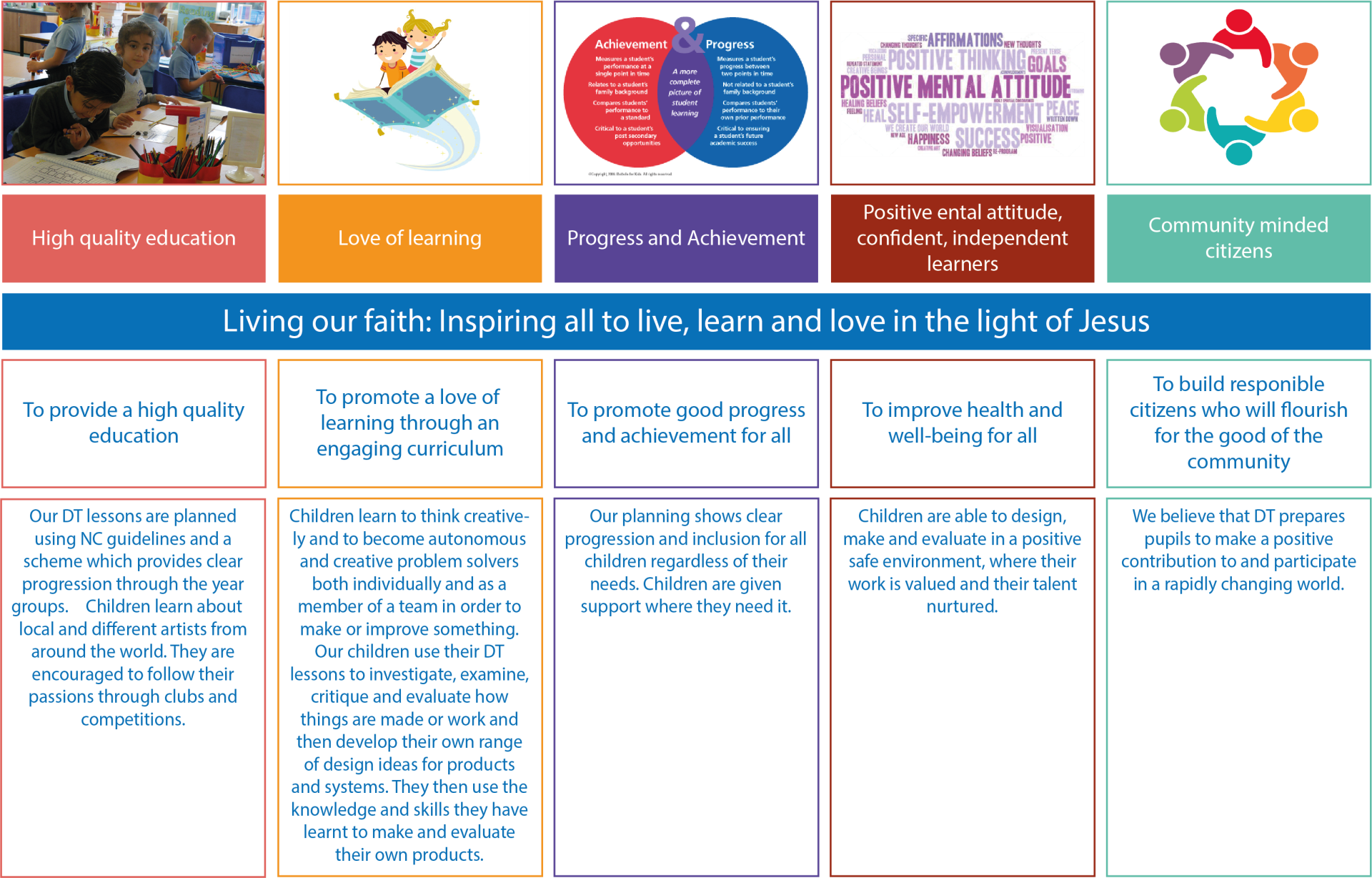St PaulinusCatholic Primary Academy
Inspiring all to live, learn and love in the light of Jesus
We are proud to work with all the Catholic schools across our two local authority areas, particularly as the Trust grows and benefits from the expertise and knowledge that other schools joining in the future will bring.
Visit UsDesign and Technology (D&T) prepares pupils to participate in a rapidly changing world. They learn to think and intervene creatively to improve the quality of life. The subject calls for pupils to become autonomous and creative problem solvers both individually and as a member of a team. They identify needs, wants and opportunities and respond to these to develop a range of design ideas for products and systems. In the process they combine practical skills with a growing understanding of aesthetic, social and environmental issues. They have the opportunity to reflect on and learn from present and past technologies. They improve their chances of becoming discriminating and informed uses of products now and in the future.
At St Paulinus we follow the national Curriculum, which clearly identifies the aims for Design Technology as:
|
Year group |
Autumn A |
Autumn B |
Spring A |
Spring B |
Summer A |
Summer B |
|
EYFS |
Key learning – To understand how a firework works (make rockets) To join different materials together to make a poppy wreath To develop fine motor skills using a range of tools To join materials together to make a stained glass window. To design, make and evaluate a Christmas biscuit. To make a Christingle. To recall the features of a fire engine
|
Key Learning – To use a range of small tools to build a bridge To join materials together – construct a vehicle To design and build the 3 little pigs houses. To design and make a Gingerbread man To create collaboratively to construct a beanstalk. To create Spring collage by exploring a variety of materials. To construct a beanstalk by joining materials.
|
Key Learning – To explore using a variety of materials – construct a minibeast. To model sea creatures To construct an underwater cave To construct a spaceship/rocket by joining materials. To join materials together – construct a floating boat To safely use tools and techniques – build a flower. To create a healthy dish |
|||
|
1 |
Y1 Mechanisms Sliders and levers – Christmas cards |
Y1 Structures Freestanding structures - playground equipment |
Y1 Food Preparing fruits and vegetables - fruit kebabs |
|||
|
2 |
Y2 Textiles Templates and joining techniques – Glove puppets |
Y2 Mechanisms Wheels and axles - moving car |
Y2 Food Preparing fruits and vegetables – fruit smoothies |
|||
|
3 |
Y3 Food Healthy and varied diet (Eatwell plate) - Making sandwiches |
Y3 Textiles 2D shape to 3D product - making a decorative panel.
|
Y3 Structures Shell structures - packaging |
|||
|
4 |
Y4 Electrical circuits Simple circuit and switches – illuminated sign |
Y4 Food Healthy and varied diet (Eatwell plate) - healthy snack bar |
Y4 Mechanisms Pneumatics – diorama with a moveable part (pneumatics)
|
|||
|
5 |
Y5 Food Celebrating culture and seasonality – making pizza |
Y5 Electrical systems More complex switches and circuits – buzz wire game |
Y5 Structures Frame structures - making teepees
|
|||
|
6 |
Y6 Food Celebrating culture and seasonality - making rice and food from other countries |
Y6 Mechanisms Pulleys and gears - a toy with moving parts |
Y6 Textiles Combining different fabric shapes - making a phone holder |
|||
Design and Technology is implemented through:
progression across year groups in all areas of DT (textiles, mechanisms, structures, food
and electrical systems)
experience
issues related to the tasks undertaken
evaluating and incorporating relevant technical knowledge and understanding in
relevant contexts.
engender an appreciation of human creativity and achievement and increase the
cultural capital from which they can draw in the future.
“You get to see how things work and then get to make your own version.”
“You learn new things, I never knew what a cam mechanism was and now I do and I made one and it worked!”
“I never knew what ingredients made a healthy snack bar. I went home and made some more.”
“My axle turned round and my car moved, it was the fastest in the class.”

